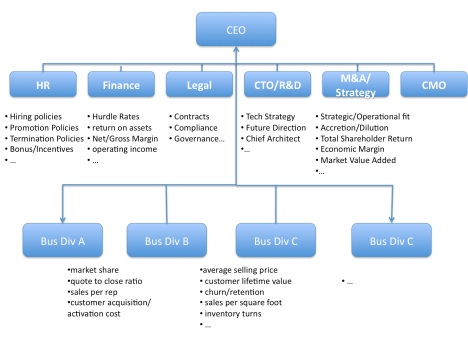net/gross margins, earnings per share, marginal cost/revenue, debt/equity, EBIDA, price earning ratio, operating income, net revenue per employee, working capital, debt to equity ratio, acid test, accounts receivable/payable turnover, asset utilization, loan loss reserves, minimum acceptable rate of return, etc.
(A consequence of using these corporate finance metrics like RONA and IRR is that it’s a lot easier to get these numbers to look great by 1) outsourcing everything, 2) getting assets off the balance sheet and 3) only investing in things that pay off fast. These metrics stack the deck against a company that wants to invest in long-term innovation.)
These financial performance indicators then drive the operating functions (sales, manufacturing, etc.) or business units that have their own execution KPI’s (market share, quote to close ratio, sales per rep, customer acquisition/activation costs, average selling price, committed monthly recurring revenue, customer lifetime value, churn/retention, sales per square foot, inventory turns, etc.)
HR Process Historically Human Resources was responsible for recruiting, retaining and removing employees to execute known business functions with known job spec’s. One of the least obvious but most important HR Process, and ultimately the most contentious, issue in corporate innovation is the difference in incentives. The incentive system for a company focused on execution is driven by the goal of meeting and exceeding “the (quarterly/yearly) plan.” Sales teams are commission-based, executive compensation is based on EPS, revenue and margin, business units on revenue and margin contribution, etc.
What Does this Mean?
Every time another execution process is added, corporate innovation dies a little more.
The conundrum is that every policy and procedure that makes a company and efficient execution machine stifles innovation.
Innovation is chaotic, messy and uncertain. It needs radically different tools for measurement and control. It needs the tools and processes pioneered in Lean Startups.
While companies intellectually understand innovation, they don’t really know how to build innovation into their culture, or how to measure its progress.
What to Do?
It may be that the current attempts to build corporate innovation are starting at the wrong end of the problem. While it’s fashionable to build corporate incubators there’s little evidence that they deliver more than “Innovation Theater.” Because internal culture applies execution measures/performance indicators to the output of these incubators and allocates resources to them the same way as it does to executing parts of company.
Corporations that want to build continuous innovation realize that innovation happens not by exception but as integral to all parts of the corporation.
To do so they will realize that a company needs innovation KPI’s, policies, processes and incentives. (Our Investment Readiness Level is just one of those metrics.) These enable innovation to occur as an integral and parallel process to execution. By design not by exception.
We’ll have more to say about this in future posts.
Lessons Learned
- Innovation inside of an existing company is much harder than a startup
- KPI’s and processes are the root cause of corporations’ inability to be agile and responsive innovators
- Every time another execution process is added, corporate innovation dies a little more
- Intellectually companies understand innovation, they don’t have the tools to put it into practice
- Companies need different policies, procedures and incentives designed for innovation
- Currently the data we use for execution models the past
- Innovation metrics need to be predictive for the future
- These tools and practices are coming…
This essay originally appeared on Steve Blank’s blog and is reposted by permission.
